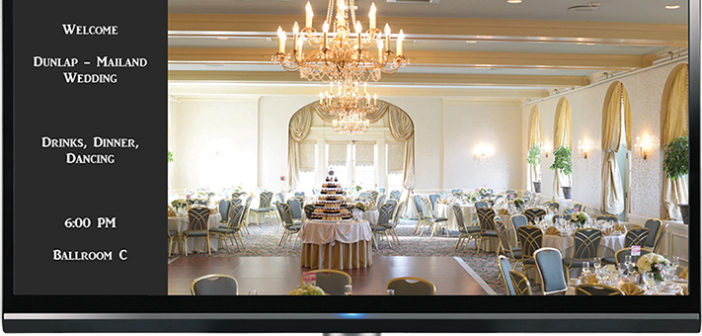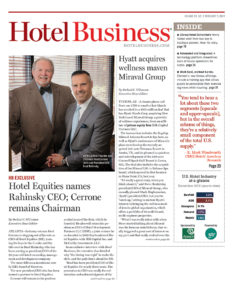DENVER—While personal devices are changing the way guests use hotel televisions, there’s no doubt that hotels need to have them. According to the AHLA’s 2016 Lodging Survey, conducted by STR and funded by the association’s educational foundation (AHLEF), high-definition and/or flat-screen TVs are in 88% of U.S. guestrooms. ADB, a company that delivers advanced TV solutions for businesses, aims to maximize the potential of these televisions with digital signage.
ADB’s vuTyme, a cloud-based in-room entertainment solution, does a lot of things you might expect from a modern in-room TV platform: live TV, VOD, a searchable interactive program guide, over-the-top services, screen casting, etc.—but it also turns a static display monitor into a digital content campaign manager without processing fees or involving a third party to manage the system.
“Depending on the system, digital signage is quite a bit of a CapEx expenditure,” said Chris Dinallo, CTO of business TV, ADB. “A typical system is in the thousands of dollars. We’ve eliminated all that extra expense. Part of our in-room entertainment solution includes the ability to turn any TV into a digital signage monitor.”
He put forth a scenario that is common for hotels: a convention is being held at the property and additional signage is needed to direct attendees where they should go for their various meetings. “They have spare televisions in the closet, so they pull those televisions out and put them in the lobby—instantly those televisions turn into digital signage,” he said, noting that traditional solutions can cost hotels thousands of dollars.
The content management system is shared through the TV’s compact set-back box, which is mounted behind the TV and stored in vuTyme’s library. The platform has a web-based portal that hotels go to so they can manage the digital signage campaigns. Hotels can dedicate one or more set-back boxes to cycle through a campaign, and choose the date, time, duration of display and the amount of time between pictures. It can also be enabled by property, by area of the hotel, by specific rooms (meeting rooms or guestrooms) or by specific boxes.
“At the press of a key, that TV now becomes a digital signage monitor. Within that same portal is a menu-driven template,” he said. “We ask the operator to tell us what they want to display—you can upload a JPEG file, video, PowerPoint—very simple things the hotel is used to creating on its own. They upload those and the template asks which monitor to display it on and what frequency and duration they want. Typically, you would put it to a continuous loop or you could alternate campaigns as well.” For instance, a TV in the F&B area can promote the day’s events at breakfast but can then be changed to promote bar specials in the evening.
Dinallo noted it can become a revenue-generating tool—both through advertising campaigns with local businesses wanting to drum up support or add-ons to events that are already being held at the hotel property. For example, if an organizer wanted to show slideshows at an event like a wedding, they could do so. “All the guest has to do is provide the pictures and the hotelier would upload them into the vuTyme system,” he said.
“Each TV is addressable individually,” Dinallo stressed, noting the hotel can choose to target just the conference attendees by putting promotions and targeted campaigns in-room. “For example, a message that says ‘Welcome attendees, there’s a special happy hour for you from 6 p.m. to 7 p.m. at the bar’… That addressability, combined with our advertising campaigns that can be set up and digital messaging, it’s really a service platform.”
He added, “Then, when the conference is over, you can take those TVs back to the closet.” Dinallo noted they could be used as spares for the televisions currently acting as in-room TVs. “If the television in room 101 breaks, you don’t buy a new one. You can use that same system that’s sitting in the closet and have it function as regular live television again. It makes it really flexible for the hotels.
“In addition to these digital signage campaigns, we have one hotel in the Atlanta area who is thinking about taking our digital signage capabilities but instead of doing these campaigns of information, turning the monitors vertically, hanging them on the wall and displaying artwork,” he continued. “The hotel gets digital redecoration anytime they want. There are themes you could do and all they’re really doing is buying a TV [and whatever artwork].” Hotels can change the artwork on a seasonal basis, or for specific events, he said—whatever fits the individual needs of that hotel.
“Compare that to buying a full on digital signage system,” Dinallo said. “Those are dedicated systems. The monitors alone cost thousands of dollars. It’s not a $400 flat-screen you go buy from a big-box store. You’re spending thousands on just the monitors, and they can’t be used for anything else. It’s quite a difference there in the flexibility we offer.”
Dinallo noted that a solution like this makes sense for all hotels “from mid-tier hotel brands all the way up to luxury hotel brands. Even economy, there is a need for it to keep guests informed of certain things.”
Dinallo concluded, “We’re enabling the capability within our system, and we let the hotels determine what their needs are.” HB


